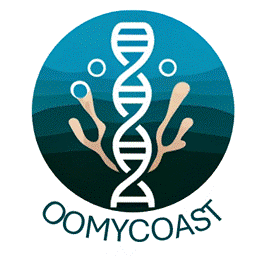Characterising Oomycetes in Brown Algae along the Norwegian Coast (OOMYCOAST)
The overarching goal of OOMYCOAST is to identify and characterise the diversity of oomycetes associated with three ecologically important species of rockweed in the intertidal and upper subtidal along the Norwegian coast: bladder wrack (Fucus vesiculosus), serrated wrack (Fucus serratus) and knotted wrack (Ascophyllum nodosum).


About the project
Oomycetes (Pseudofungi) are a class of filamentous, fungus-like, eukaryotic organisms that are important pathogens and saprotrophs of a range of organisms, including seaweeds, both kelp and rockweed. So far, we have very limited knowledge about marine oomycetes in Norway (zero marine coastal species registered in the Norwegian Biodiversity Information Centre Species Map).
Despite their ubiquity and ecological importance, the species diversity and distribution patterns of marine oomycetes are largely unknown. DNA-based studies have revealed that oomycetes are an abundant and species-rich group of eukaryotes. Currently, there are >1200 named oomycete species, but it has been estimated that only around 10% of the global oomycete species diversity is known. New species are being discovered at a high pace, and the pathogenicity and host range of these novel taxa are often unknown. Basic information about taxonomy and epidemiology of marine oomycete seaweed pathogens in Norway has so far been a black box. This project will be the first systematic survey of the distribution and diversity of oomycetes associated with three common species of rockweed in the intertidal and upper subtidal along the Norwegian coast; Fucus vesiculosus, F. serratus and Ascophyllum nodosum.
We will use modern molecular methods (high-throughput short- and long-read DNA sequencing techniques) in conjunction with cultivation experiments and microscopy techniques to provide solid documentation of the morphology, physiology, taxonomy, and phylogenetic placement of novel rockweed-associated oomycetes. Through strategic field sampling along the Norwegian coast, we will cover the main ecoregions and environmental gradients, allowing us to obtain a comprehensive overview of the distribution and diversity of oomycetes associated with ecologically important rockweeds. Seaweed-associated oomycetes constitute a diverse and species-rich organismal group, and we expect to discover several new species that will be taxonomically described.

 Marit Frederikke Markussen Bjorbækmo
Marit Frederikke Markussen Bjorbækmo
 Trine Bekkby
Trine Bekkby
 Sandra Stadniczenko Gran
Sandra Stadniczenko Gran

